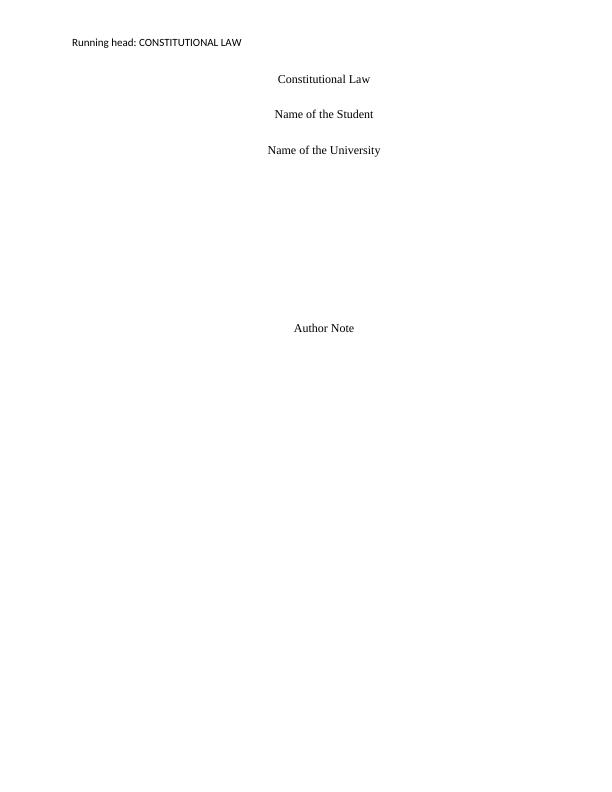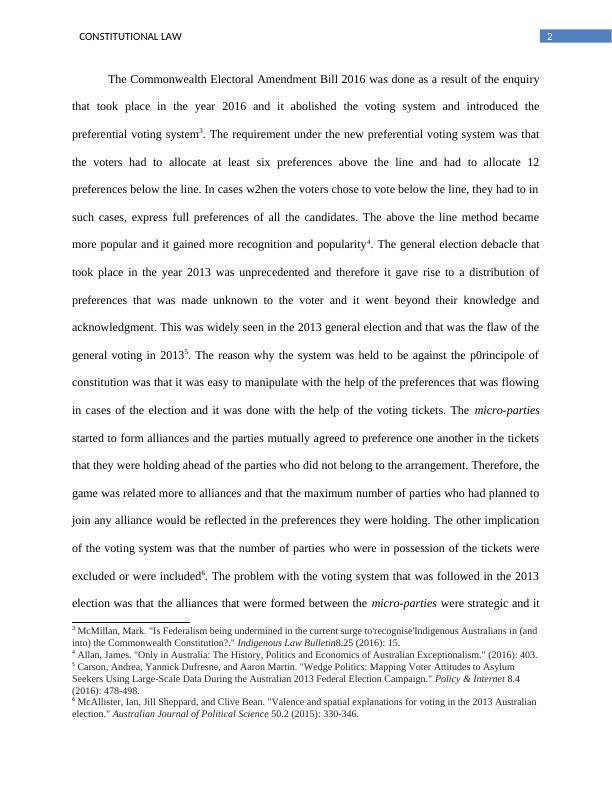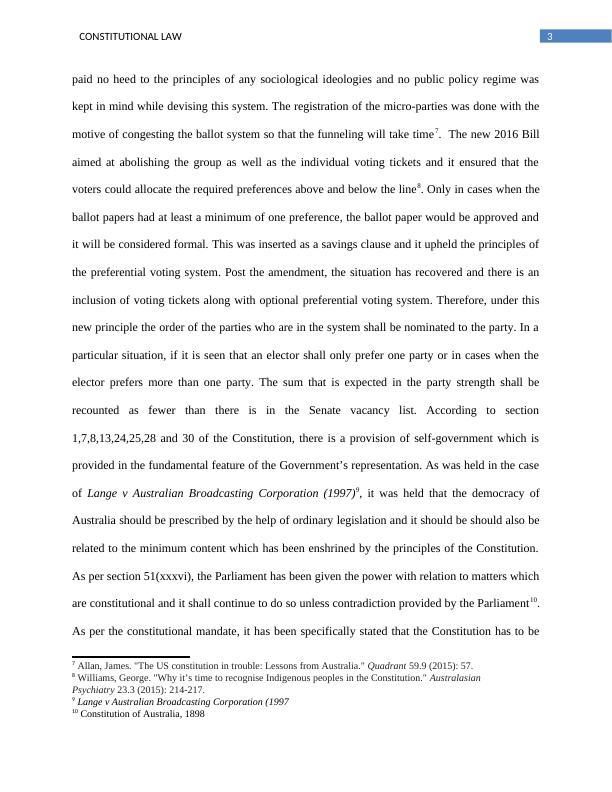Constitutional Law: Analysis of Electoral System in Australia
Discuss and compare the current system of electing the members of the Senate with an optional preferential system and critically analyze the difference(s). Determine which voting method for the Senate best advances the objective of representative government contained in the Constitution.
18 Pages6199 Words148 Views
Added on 2023-06-15
About This Document
This article analyzes the electoral system in Australia and its compliance with constitutional law provisions. It discusses the changes made in the system and the impact of those changes on the voting process.
Constitutional Law: Analysis of Electoral System in Australia
Discuss and compare the current system of electing the members of the Senate with an optional preferential system and critically analyze the difference(s). Determine which voting method for the Senate best advances the objective of representative government contained in the Constitution.
Added on 2023-06-15
ShareRelated Documents
Running head: CONSTITUTIONAL LAW
Constitutional Law
Name of the Student
Name of the University
Author Note
Constitutional Law
Name of the Student
Name of the University
Author Note

1CONSTITUTIONAL LAW
The electoral system that has been followed in the House of Representatives has
remained same since the year1918 and there has not been much change to that system. Fresh row
and debate started over the electoral reform in the year 20131. The contention that arose was
regards to the voting tickets that were allowed to the ‘micro-parties’. The ticket has given the
power to the micro parties a direct preference in the voting system which is inconsistent with the
way votes need to be conducted as they are against the voter’s expectations. The resultant of this
preference is that candidates who have very little primary votes (0.5 per cent) have been elected.
What followed post this issues was that there was a joint committee meeting conducted to
enquire into the alleged terms of reference. The election enquiry was instituted to ensure that the
reforms could be made ahead of the next election and that the electoral system could be
amended. It is pertinent to analyze and find ways to resolve the conflict with the help of
constitutional law provisions. The Senate election was done in accordance with the ballot
structure which mandated that the voting shall be done above and below the line in consonance
with the ballot structure. The reforms came in the year 2016 and before that the ticket voting
system was followed which ensured that the voting shall be initiated with full preferences above
the line and the voting below the line. The list system that was followed was for the benefit of
the voting process so that there is more transparency. This was therefore important as it was
necessary under this situation to implement the recommendations that was made by the Joint
Select Committee on Electoral Reforms. The parties or the groups who were intending to be part
of the electoral system has to register themselves and then they could propose the Electoral
Commission2.
1 Plouffe, Michael, and Roos van der Sterren. "Trading representation: Diplomacy’s influence on preferential trade
agreements." The British Journal of Politics and International Relations 18.4 (2016): 889-911.
2 Gauja, Anika. "Party dimensions of representation in Westminster parliaments: Australia, New Zealand and the
United Kingdom: Anika Gauja." Parliamentary Roles in Modern Legislatures. Routledge, 2015. 147-170.
The electoral system that has been followed in the House of Representatives has
remained same since the year1918 and there has not been much change to that system. Fresh row
and debate started over the electoral reform in the year 20131. The contention that arose was
regards to the voting tickets that were allowed to the ‘micro-parties’. The ticket has given the
power to the micro parties a direct preference in the voting system which is inconsistent with the
way votes need to be conducted as they are against the voter’s expectations. The resultant of this
preference is that candidates who have very little primary votes (0.5 per cent) have been elected.
What followed post this issues was that there was a joint committee meeting conducted to
enquire into the alleged terms of reference. The election enquiry was instituted to ensure that the
reforms could be made ahead of the next election and that the electoral system could be
amended. It is pertinent to analyze and find ways to resolve the conflict with the help of
constitutional law provisions. The Senate election was done in accordance with the ballot
structure which mandated that the voting shall be done above and below the line in consonance
with the ballot structure. The reforms came in the year 2016 and before that the ticket voting
system was followed which ensured that the voting shall be initiated with full preferences above
the line and the voting below the line. The list system that was followed was for the benefit of
the voting process so that there is more transparency. This was therefore important as it was
necessary under this situation to implement the recommendations that was made by the Joint
Select Committee on Electoral Reforms. The parties or the groups who were intending to be part
of the electoral system has to register themselves and then they could propose the Electoral
Commission2.
1 Plouffe, Michael, and Roos van der Sterren. "Trading representation: Diplomacy’s influence on preferential trade
agreements." The British Journal of Politics and International Relations 18.4 (2016): 889-911.
2 Gauja, Anika. "Party dimensions of representation in Westminster parliaments: Australia, New Zealand and the
United Kingdom: Anika Gauja." Parliamentary Roles in Modern Legislatures. Routledge, 2015. 147-170.

2CONSTITUTIONAL LAW
The Commonwealth Electoral Amendment Bill 2016 was done as a result of the enquiry
that took place in the year 2016 and it abolished the voting system and introduced the
preferential voting system3. The requirement under the new preferential voting system was that
the voters had to allocate at least six preferences above the line and had to allocate 12
preferences below the line. In cases w2hen the voters chose to vote below the line, they had to in
such cases, express full preferences of all the candidates. The above the line method became
more popular and it gained more recognition and popularity4. The general election debacle that
took place in the year 2013 was unprecedented and therefore it gave rise to a distribution of
preferences that was made unknown to the voter and it went beyond their knowledge and
acknowledgment. This was widely seen in the 2013 general election and that was the flaw of the
general voting in 20135. The reason why the system was held to be against the p0rincipole of
constitution was that it was easy to manipulate with the help of the preferences that was flowing
in cases of the election and it was done with the help of the voting tickets. The micro-parties
started to form alliances and the parties mutually agreed to preference one another in the tickets
that they were holding ahead of the parties who did not belong to the arrangement. Therefore, the
game was related more to alliances and that the maximum number of parties who had planned to
join any alliance would be reflected in the preferences they were holding. The other implication
of the voting system was that the number of parties who were in possession of the tickets were
excluded or were included6. The problem with the voting system that was followed in the 2013
election was that the alliances that were formed between the micro-parties were strategic and it
3 McMillan, Mark. "Is Federalism being undermined in the current surge to'recognise'Indigenous Australians in (and
into) the Commonwealth Constitution?." Indigenous Law Bulletin8.25 (2016): 15.
4 Allan, James. "Only in Australia: The History, Politics and Economics of Australian Exceptionalism." (2016): 403.
5 Carson, Andrea, Yannick Dufresne, and Aaron Martin. "Wedge Politics: Mapping Voter Attitudes to Asylum
Seekers Using Large‐Scale Data During the Australian 2013 Federal Election Campaign." Policy & Internet 8.4
(2016): 478-498.
6 McAllister, Ian, Jill Sheppard, and Clive Bean. "Valence and spatial explanations for voting in the 2013 Australian
election." Australian Journal of Political Science 50.2 (2015): 330-346.
The Commonwealth Electoral Amendment Bill 2016 was done as a result of the enquiry
that took place in the year 2016 and it abolished the voting system and introduced the
preferential voting system3. The requirement under the new preferential voting system was that
the voters had to allocate at least six preferences above the line and had to allocate 12
preferences below the line. In cases w2hen the voters chose to vote below the line, they had to in
such cases, express full preferences of all the candidates. The above the line method became
more popular and it gained more recognition and popularity4. The general election debacle that
took place in the year 2013 was unprecedented and therefore it gave rise to a distribution of
preferences that was made unknown to the voter and it went beyond their knowledge and
acknowledgment. This was widely seen in the 2013 general election and that was the flaw of the
general voting in 20135. The reason why the system was held to be against the p0rincipole of
constitution was that it was easy to manipulate with the help of the preferences that was flowing
in cases of the election and it was done with the help of the voting tickets. The micro-parties
started to form alliances and the parties mutually agreed to preference one another in the tickets
that they were holding ahead of the parties who did not belong to the arrangement. Therefore, the
game was related more to alliances and that the maximum number of parties who had planned to
join any alliance would be reflected in the preferences they were holding. The other implication
of the voting system was that the number of parties who were in possession of the tickets were
excluded or were included6. The problem with the voting system that was followed in the 2013
election was that the alliances that were formed between the micro-parties were strategic and it
3 McMillan, Mark. "Is Federalism being undermined in the current surge to'recognise'Indigenous Australians in (and
into) the Commonwealth Constitution?." Indigenous Law Bulletin8.25 (2016): 15.
4 Allan, James. "Only in Australia: The History, Politics and Economics of Australian Exceptionalism." (2016): 403.
5 Carson, Andrea, Yannick Dufresne, and Aaron Martin. "Wedge Politics: Mapping Voter Attitudes to Asylum
Seekers Using Large‐Scale Data During the Australian 2013 Federal Election Campaign." Policy & Internet 8.4
(2016): 478-498.
6 McAllister, Ian, Jill Sheppard, and Clive Bean. "Valence and spatial explanations for voting in the 2013 Australian
election." Australian Journal of Political Science 50.2 (2015): 330-346.

3CONSTITUTIONAL LAW
paid no heed to the principles of any sociological ideologies and no public policy regime was
kept in mind while devising this system. The registration of the micro-parties was done with the
motive of congesting the ballot system so that the funneling will take time7. The new 2016 Bill
aimed at abolishing the group as well as the individual voting tickets and it ensured that the
voters could allocate the required preferences above and below the line8. Only in cases when the
ballot papers had at least a minimum of one preference, the ballot paper would be approved and
it will be considered formal. This was inserted as a savings clause and it upheld the principles of
the preferential voting system. Post the amendment, the situation has recovered and there is an
inclusion of voting tickets along with optional preferential voting system. Therefore, under this
new principle the order of the parties who are in the system shall be nominated to the party. In a
particular situation, if it is seen that an elector shall only prefer one party or in cases when the
elector prefers more than one party. The sum that is expected in the party strength shall be
recounted as fewer than there is in the Senate vacancy list. According to section
1,7,8,13,24,25,28 and 30 of the Constitution, there is a provision of self-government which is
provided in the fundamental feature of the Government’s representation. As was held in the case
of Lange v Australian Broadcasting Corporation (1997)9, it was held that the democracy of
Australia should be prescribed by the help of ordinary legislation and it should be should also be
related to the minimum content which has been enshrined by the principles of the Constitution.
As per section 51(xxxvi), the Parliament has been given the power with relation to matters which
are constitutional and it shall continue to do so unless contradiction provided by the Parliament10.
As per the constitutional mandate, it has been specifically stated that the Constitution has to be
7 Allan, James. "The US constitution in trouble: Lessons from Australia." Quadrant 59.9 (2015): 57.
8 Williams, George. "Why it’s time to recognise Indigenous peoples in the Constitution." Australasian
Psychiatry 23.3 (2015): 214-217.
9 Lange v Australian Broadcasting Corporation (1997
10 Constitution of Australia, 1898
paid no heed to the principles of any sociological ideologies and no public policy regime was
kept in mind while devising this system. The registration of the micro-parties was done with the
motive of congesting the ballot system so that the funneling will take time7. The new 2016 Bill
aimed at abolishing the group as well as the individual voting tickets and it ensured that the
voters could allocate the required preferences above and below the line8. Only in cases when the
ballot papers had at least a minimum of one preference, the ballot paper would be approved and
it will be considered formal. This was inserted as a savings clause and it upheld the principles of
the preferential voting system. Post the amendment, the situation has recovered and there is an
inclusion of voting tickets along with optional preferential voting system. Therefore, under this
new principle the order of the parties who are in the system shall be nominated to the party. In a
particular situation, if it is seen that an elector shall only prefer one party or in cases when the
elector prefers more than one party. The sum that is expected in the party strength shall be
recounted as fewer than there is in the Senate vacancy list. According to section
1,7,8,13,24,25,28 and 30 of the Constitution, there is a provision of self-government which is
provided in the fundamental feature of the Government’s representation. As was held in the case
of Lange v Australian Broadcasting Corporation (1997)9, it was held that the democracy of
Australia should be prescribed by the help of ordinary legislation and it should be should also be
related to the minimum content which has been enshrined by the principles of the Constitution.
As per section 51(xxxvi), the Parliament has been given the power with relation to matters which
are constitutional and it shall continue to do so unless contradiction provided by the Parliament10.
As per the constitutional mandate, it has been specifically stated that the Constitution has to be
7 Allan, James. "The US constitution in trouble: Lessons from Australia." Quadrant 59.9 (2015): 57.
8 Williams, George. "Why it’s time to recognise Indigenous peoples in the Constitution." Australasian
Psychiatry 23.3 (2015): 214-217.
9 Lange v Australian Broadcasting Corporation (1997
10 Constitution of Australia, 1898

End of preview
Want to access all the pages? Upload your documents or become a member.
Related Documents
Party system of australia and its efficiencylg...
|12
|3813
|18
Canadian System of Governancelg...
|4
|750
|452
